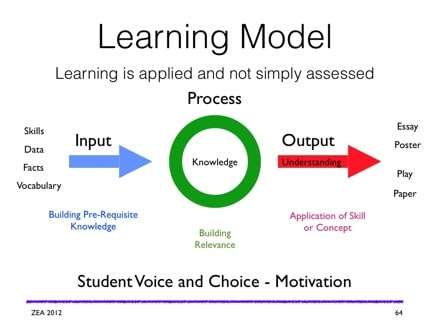Direct Instruction? That’s the Old Way
CompetencyWorks Blog
 I met with a group of teachers yesterday for our monthly check in. The group is made up of individuals that willingly volunteered to try some of the processes and procedures of a customized classroom. They are omnivorous learners. They are the energetic group that is willing to jump in, give it a try, reflect, and then adjust. They are not concerned about building the airplane while it is flying. They have absolute confidence they can hit the exhaust vent and blow up the Death Star. . .most likely finding Obi-Wan Kenobi’s constant reminders as irritating; Yea, yea I got it. The Force. But, even with their voracious appetite and willingness to find the path through the ambiguity, they can sometimes talk themselves astray.
I met with a group of teachers yesterday for our monthly check in. The group is made up of individuals that willingly volunteered to try some of the processes and procedures of a customized classroom. They are omnivorous learners. They are the energetic group that is willing to jump in, give it a try, reflect, and then adjust. They are not concerned about building the airplane while it is flying. They have absolute confidence they can hit the exhaust vent and blow up the Death Star. . .most likely finding Obi-Wan Kenobi’s constant reminders as irritating; Yea, yea I got it. The Force. But, even with their voracious appetite and willingness to find the path through the ambiguity, they can sometimes talk themselves astray.
The issue this month: the role of direct instruction. Somehow, somewhere, someway, the idea that a teacher should talk directly with students has become part of the “old way.” The idea that students need to “learn on their own” is the new way. We want learners who can figure this stuff out. They need to struggle, ask questions, and seek those answers using their own reasoning. “Direct instruction is so old school. I need to get out of their way.”
This was not the first time I had heard that customized learning meant stepping out of students’ way. I was just surprised that it was being mentioned by my colleagues. I had worked hard to not allow that idea to sink in. I firmly believe that the direct instruction of material from the expert (the teacher) to the novice (the learner) is a legitimate and effective means of the transfer of information, data, facts, and skills. While teachers should refrain from giving out answers and allow students the opportunity to struggle, they need to be in the middle, monitoring, prompting, and guiding during all steps of the learning process, especially as the students begin to construct relevance from classroom lessons. It’s what I like to call the “input” step of the learning process.
It is also necessary in “Processing”, the second step. In this step, students take the information that has been inputted and they work to build relevance and meaning. How they choose to demonstrate their understanding is referred to as the “output.” They turn the facts into knowledge and create an understanding that is relevant to how they will demonstrate their learning. Vygotsky told us that learning is social. It requires the talking out of ideas to make them more meaningful. If we do not process them with someone who has a deeper knowledge, it is like practicing tennis against weaker opponents–not the best plans to make Wimbledon. You will not improve if you are not challenged.
Direct instruction is definitely different in a customized classroom then the sit-n-get model. Here are a few important distinctions:
1. First of all, direct instruction is not learning. It is just one piece in the learning process. Whatever is introduced through direct instruction will need to be applied with feedback to students to ensure they have mastered the material. Learning occurs when there is a transfer of knowledge from the educational setting to a novel situation. If I only lecture and then assess what you heard in my lecture, I am not testing for understanding. Learning needs to be applied and not simply assessed.
2. Students are engaged in direct instruction because they are engaged in their learning. You don’t have to be the sage on the stage. We could never fill our schools with enough thespians or storytellers who can keep us on the edge of our seats while they create magnificent images in our heads using only words. The engagement comes from how effectively you are sharing your expertise.
3. Direct instruction is often confused with whole group lecture style delivery. In customized classrooms, direct instruction can be delivered to one student, a small group of the full class. While it is occasionally necessary to address the whole group, you should do so carefully. Have you pre-assessed to determine the whole group needs it? Is it information that is going to be delivered in such a way that students struggling can benefit by hearing from their peers who already understand? Try problem solving in a whole group using a Socratic method instead of lecture. If your plan is to tell the whole group either with little or no questions and discussion, then it probably should be done with those who need it in a group or individual conference so you have a chance to assess how they are understanding.
4. Direct instruction is not the only means of input gathering. There are numerous ways that students can get input. Video sources, reading, your recorded lectures, other students who have been identified as experts — all can act as means of input gathering. As much as possible, allow for student voice and choice when tapping into expertise.
It’s helpful to think about how we as adults draw on experts as part of our learning. When I wanted to install hardwood floors, I consulted experts, went to workshops, watched Youtube videos, and read online reviews and blog posts from those who completed the task before me. I needed a mix of input, a chance to reflect, and people who could help me make sense as well as help when I made mistakes. Think about how you would go about pulling and processing information to make a decision. What would you do? Would you rely on others, or simply decide on your own? When you pursue your own learning at conferences and workshops, do you learn best by sitting and listening, reading, asking questions, doing and practicing, reflecting, or a combination of these?
So what it comes down to is that in a customized classroom we get out of the students way to learning and into the very midst of their journey of learning. We are there when they need us and away when they do not.
Nina Lopez is an independent consultant, based in Boulder, CO. Nina provides facilitation, strategy and innovation design services to private foundations, non-profit and government entities in Colorado and throughout the country to help them incubate new initiatives, develop a shared vision and a clear strategy for achieving individual and collective goals. www.ninalopez.com
